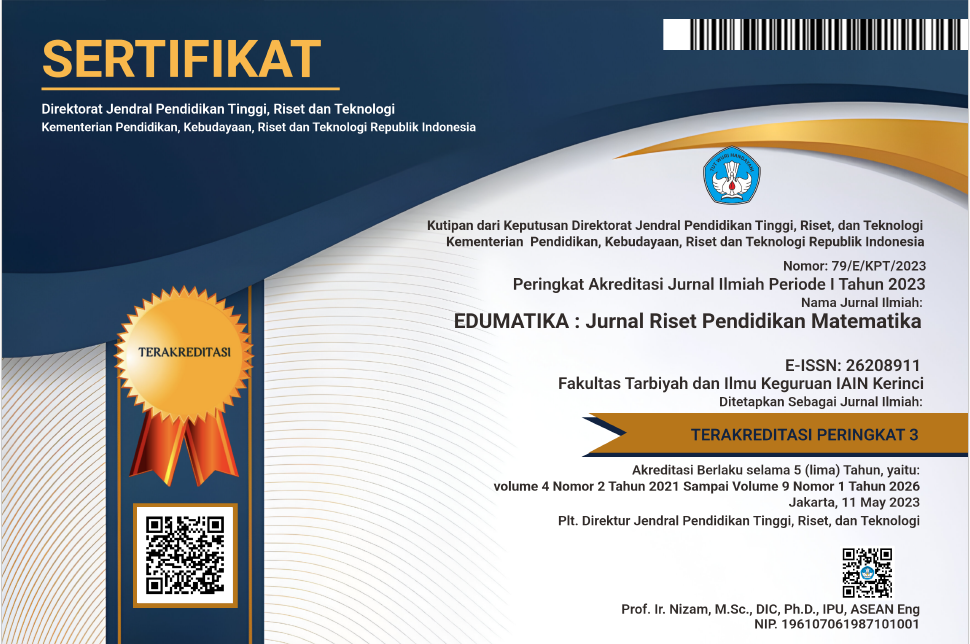The Metaphorical Thinking of Junior High School Students in Solving Algebra Problems
Abstract
Metaphorical thinking is one way of thinking in building abstract concepts through concrete things. Abstract ideas in metaphorical thinking are metaphorized into real-world things. This study aims to describe the metaphorical thinking profile of junior high school students in solving algebraic problems. The problem-solving steps used are the Polya model and the stages of metaphorical thinking using the CREATE criteria by Siler. This research is qualitative research using a descriptive approach. This study involved one of the seventh-grade students in a private junior high school in Surabaya who got the highest score on the preliminary test, namely the mathematical ability test. The data collecting technique employed in this study was problem-solving assignments and semi-structured interviews. Time triangulation was performed to assess the data from this study's credibility. Based on the analysis results, the subject has not been optimal in revealing the CREATE criteria for metaphorical thinking. The research subject has not been able to find a suitable metaphor for the algebra problem, so the subject did not reveal the Connect and Relate criteria. However, the subject revealed Explore criteria by designing mathematical models on the algebraic problem. The subject was able to determine the mathematical processes needed to solve the problem for the Analyze criteria, and the subject was also able to explain the procedures she took before. The subject discovered the Transform criteria by inferring and interpreting data based on earlier work. Last, the subject revealed the Experience criteria by explaining a new challenge using the model that had been created previously.
Downloads
References
Annizar, A. M., & Zahro, F. S. (2020). Proses Berpikir Metafora dalam Menyelesaikan Masalah Matematis Soal HOTS Berdasarkan Kemampuan Kognitif Siswa. Jurnal Tadris Matematika, 3(2), 117–130. https://doi.org/10.21274/jtm.2020.3.2.117-130
Arni, N. C. (2019). Profil Berpikir Metaforis Siswa SMP Dalam Memecahkan Masalah Matematika Ditinjau Dari Gaya Kognitif. 7(2), 85–96.
Bellanca, J. A. (2015). The focus factor: 8 essential twenty-first century thinking skills for deeper student learning. Teachers College Press.
Demirel, M., Derman, I., & Karagedik, E. (2015). A Study on the Relationship between Reflective Thinking Skills towards Problem Solving and Attitudes towards Mathematics. Procedia - Social and Behavioral Sciences, 197(February), 2086–2096. https://doi.org/10.1016/j.sbspro.2015.07.326
Devlin, K. (2012). Introduction to Mathematical Thinking. Keith Devlin.
Komang, N., & Febriyanti, S. (2020). Mathematics Learning Interest of Elementary School Students in Using Metaphorical Thinking Learning Model. Journal Of Education Technology, 4(3), 273–278.
Lubis, W. A., Ariswoyo, S., & Syahputra, E. (2020). Kemampuan Pemecahan Masalah Matematika Melalui Pendekatan Pendidikan Matematika Realistik dan Pendekatan Penemuan Terbimbing Berbantuan Autograph. Edumatika: Jurnal Riset Pendidikan Matematika, 3(1), 1. https://doi.org/10.32939/ejrpm.v3i1.483
Memnun, D. S., Hart, L. C., & Akkaya, R. (2012). A Research on the Mathematical Problem Solving Beliefs of Mathematics, Science and Elementary Pre-Service Teachers in Turkey in terms of Different Variables. International Journal of Humanities and Social Science, 2(24), 172–184. www.ijhssnet.com
Noviani, J. (2016). Profil Berpikir Metaforis Siswa SMP dalam Memecahkan Masalah Aljabar ditinjau dari Tipe Kepribadian. Universitas Negeri Surabaya.
Nurfitri, & Mardiana, D. (2019). Penerapan pendekatan Realistic Mathematic Education (RME) untuk meningkatkan kemampuan berpikir metafora peserta didik SMP. UJMES (Uninus Journal of Mathematics Education and Science), 4(1), 15–27. http://ojs.uninus.ac.id/index.php/UJMES/article/view/841
Polya, G. (1973). How to Solve It: A New Aspect of Mathematical Method (Second Edi). Princeton University Press.
Sanchez-Ruiz, M. J., Santos, M. R., & Jiménez, J. J. (2013). The Role of Metaphorical Thinking in the Creativity of Scientific Discourse. Creativity Research Journal, 25(4), 361–368. https://doi.org/10.1080/10400419.2013.843316
Setiawan, W. (2016). Profil Berpikir Metaforis (Metaphorical Thinking) Siswa SMP dalam Memecahkan Masalah Pengukuran Ditinjau dari Gaya Kognitif. Jurnal Matematika Kreatif-Inovatif, 7(2), 2018–2216.
Siler, T. (1996). Think Like a Genius. In Mechanical Engineering (Vol. 137, Issue 8). Art Science Publications. http://search.ebscohost.com/login.aspx?direct=true&db=asn&AN=108502153&lang=es&site=ehost-live
Simpol, N. S. H., Shahrill, M., Li, H. C., & Prahmana, R. C. I. (2018). Implementing thinking aloud pair and Pólya problem solving strategies in fractions. Journal of Physics: Conference Series, 943(1). https://doi.org/10.1088/1742-6596/943/1/012013
Singh, P., Teoh, S. H., Cheong, T. H., Md Rasid, N. S., Kor, L. K., & Md Nasir, N. A. (2018). The Use of Problem-Solving Heuristics Approach in Enhancing STEM Students Development of Mathematical Thinking. International Electronic Journal of Mathematics Education, 13(3), 289–303. https://doi.org/10.12973/iejme/3921
Treffinger, D. J., Selby, E. C., & Isaksen, S. G. (2008). Understanding individual problem-solving style: A key to learning and applying creative problem solving. Learning and Individual Differences, 18(4), 390–401. https://doi.org/10.1016/j.lindif.2007.11.007
van den Heuvel-Panhuizen, M., Kolovou, A., & Robitzsch, A. (2013). Primary school students’ strategies in early algebra problem solving supported by an online game. Educational Studies in Mathematics, 84(3), 281–307. https://doi.org/10.1007/s10649-013-9483-5
Wahyu, D., Relawati, M., & Lukito, A. (2020). Metaphorical Thinking of Students with Different Sensing Personality Types in Solving Algebra Problems. Jurnal Ilmiah Pendidikan Matematika, 9(2), 267–275.
Walfurqan. (2015). Profil Berpikir Metaforis dalam Memecahkan Masalah Aljabar Ditinjau dari Perbedaan Kemampuan Matematika. Universitas Negeri Surabaya.
Walfurqan. (2020). Investigating of Students ’ Methaporical Thinking in Solving Algebra Problems. Journal of Mathematical Pedagogy, 1(2), 54–61.
Zanartu, C. R., Doerr, P., & Portman, J. (2015). Teaching 21 thinking skills for the 21st century: The MiCOSA model. Pearson.
Copyright (c) 2022 Julia Noviani

This work is licensed under a Creative Commons Attribution 4.0 International License.















